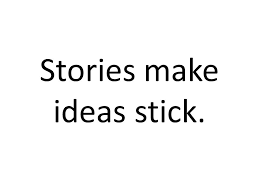The story is a powerful and persuasive communication device capable of bringing people into dreams, to take on big ideas and to do great things, such as the transition to a new normal. Stories engage our senses and trigger thoughts, memories and emotions simultaneously. They engage us, so we remember more likely what we heard. The power of the story goes beyond the audience. When we exchange stories together, our minds are aligned with their audience. It brings together our minds and aligns our emotions too. This process of "neural coupling" brings people’s minds together and also aligns our emotions with them.
Oxytocin, the love hormone, is released when we feel connected with another person through stories, flooding our bodies with positive affection for others. This connection influences us to act. So, storytelling is more than fun and for children at bedtime; storytelling is an invaluable ability for anyone who wants to relate to and act with other people. It's a powerful, convincing communication device that can help you, your teams and your whole organization do things. This is why it makes sense to invest in building your employees' storytelling skills.
As a first step, understanding the mechanics of stories is necessary. Why do you develop storytelling as a skilled skill, for example?
First, all stories follow a fundamental structure of three acts.
Act I is the beginning, where a likeable hero is always put into action.
Act II is the Messy Middle, where the hero meets obstacles and challenges.
Act III is the end in which the hero overcomes and transforms those challenges.
Notice how transformation is integrated into the historic structure. Every story has the potential to alter us. Because we all have to tell stories, everyone can be told from many points of view. We all have the potential to use stories to bring about change. With Edmodo Classroom is an ideal tool for storytelling and we have seen that the narrative can be used in 4 effective ways through our work with top-performing brands and leaders.
1. Stories tell our identity
Since our stories describe our experiences and challenges we have had to face, they define how we see ourselves and how others perceive us. The experiences we are going through now have a profound impact on us.
Indeed, the messy centrepiece of the story is where we experience the greatest change. By tackling obstacles, tests and tests and overcoming them, we develop new muscles and learn new skills that change our core identity. We have to tell those stories so that other people can learn from them and change them as well.
2. Stories convey insights
Stories can help us find meaning in data that enables us to decide and take action. Data insights are critical to our mission and how we use them this season will make or break up our businesses. Whether it's market share, employee headcount or financial resources, data can be a problem or an opportunity. Data can be a problem. However, no matter how much data your business has, the value is lost if people are unable to communicate insights effectively.
By creating actionable recommendations that follow the structure of the three acts, you create a Data Story. This framework helps you to communicate insights in such a way that decision-making is accelerated. Many who make a positive transition from merely analyzing data to explaining it effectively will quickly rise to the ranks of their organizations. These data historians are respected, strategic consultants.

3. Stories make stick ideas
They are more likely to be talked about and gain traction by wrapping ideas in an emotive and memorable package, like a story. Stories have an integrated structure, tension and form that allows us to point out the differences between our present and desired conditions.
This gap – the contrast – between now and the future enable us to see new possibilities and to understand how your idea can change our world. In contrast, where we are and where we need to go, you can make people more open to transformation and create a desire for that alternative future.

4. History drives action and influence
Stories convey our main concepts, from identity, insight and ideas. But stories can do more; they can be an important instrument for driving change. We have found that efforts to change – both social movements and organization shifts – are also a reflection of the classic 3-act structure in research. At first, leaders are communicating a dream and asking people to take a leap. In the messy middle of the day, people are asked to fight past obstacles and get closer to the goal. In the last action, they all come and take a moment to reflect on the journey before they prepare to repeat it.
At every point of this journey of transformation, leaders must communicate well using the principles of storytelling to illuminate the path ahead. Whether it is by speeches, ceremonies or symbols, history helps to create momentum that inspires and sustains change. Right now, we are experiencing a defining moment in our enterprises, our careers and even our society. It can't be a more important time to influence people — and history is a powerful instrument to do so.

